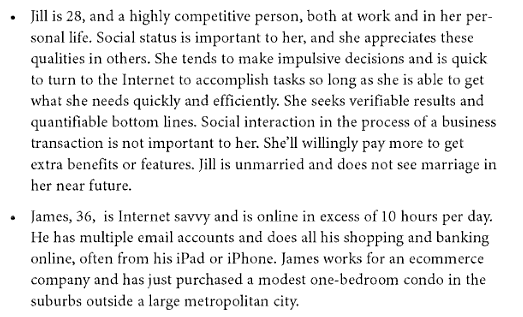In a previous blog post, Finding your voice: Content marketing dos, we mentioned the importance of content marketing, and how it is necessary to constantly publish content so that you are providing value to your clients, and so that search engines display your web content in organic search results. But, you may be wondering, “what should my content say?”
Granted, this will depend on your goals and your audience. In her book Content Marketing, digital marketing expert Rebecca Lieb suggests creating personas for the each of your target audience; boil down your customers into a group of individuals that represent your clientele. Creating personas will help you to segment your audience and understand what interests them. Only after you do this, will you be able to determine what types of content you should be sharing.
Write a short paragraph that tells the age, personality and interests of a specific client type. Below are two examples of persona types taken from Leib’s book, Content Marketing.
Don’t create content for everyone. Direct it at a specific person – direct it at Jill or James. If you truly know your audience, then you will be able to provide them with content that interests them.
Once you have determined whom you are speaking to, you can begin to write. There are three main categories of content.
1. Content that entertains.
What are people talking about at the water cooler? Usually it is the funny stories that they have heard, the stories that make them laugh and smile. So, let that be you!
For example, you may recall, after the Superbowl we discussed our favorite ads. Our favorites, and the favorites of most of the nation, were the ads that entertained – the funny ones. This is what we then talked about on our Facebook page and in our Tweets, giving more exposure to the companies in the ads.
2. Content that educates.
People turn to the Internet for information, so be sure that you are providing the information they need, and more. This is especially important if you are selling a service, or something intangible. During the buying cycle people want to learn about the service or a product. If people see that you are knowledgeable about various related products and services, and the industry at large, they will trust you, and when it comes time to buy, they will turn to you.
Hubspot sells marketing software. By publishing endless amounts of content geared toward marketing experts, they have established themselves as top experts in the field. They constantly share webinars, whitepapers, ebooks, videos, research reports, etc, and in return ask for the readers email address, which enables them to convert leads into sales. By sharing content that educates, Hubspot has grown tremendously. (In 2011, they reported over 2,000 new customers, and grown revenues from $16 million to $29 million.)
3. Content that provides use.
When most people think on content, they likely think of words, photos, and videos, but content can be more. Content can come in the form of a tool, something that provides utility. For example, an app that tells you the local weather, a calculator that will help customers determine their taxes, an app developed to enable customers to create and order their favorite pizza, or a tool to help runners track the mileage of their run. Providing a tool that is useful to your target audience is a sure way to keep them engaged, and returning to your site, while keeping in mind brand awareness. And, today as more and more of the population is turning to smartphones, apps are becoming more relevant.
By understanding the different types on content, you can determine which is best for your target audience. You may need a combination of all content genres, or you may need to just focus on one. Again, this depends on what you are selling, and who you are selling to.
~ Michelle Loeb, social media and content strategist



Leave a Reply